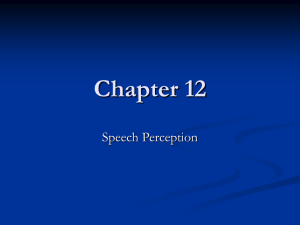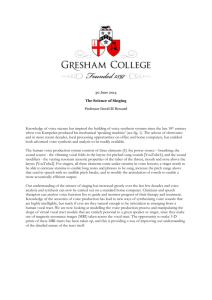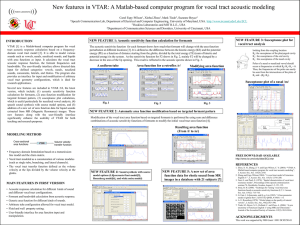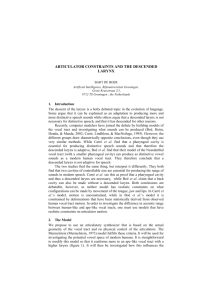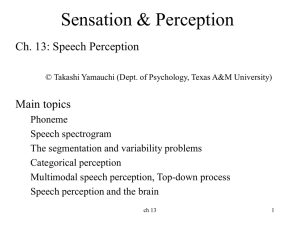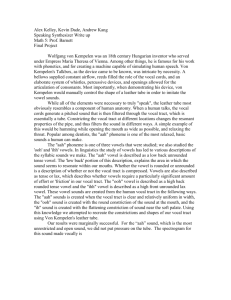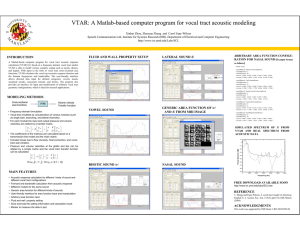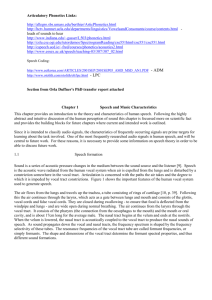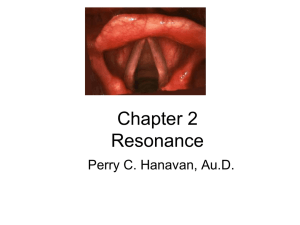Speech Perception
advertisement
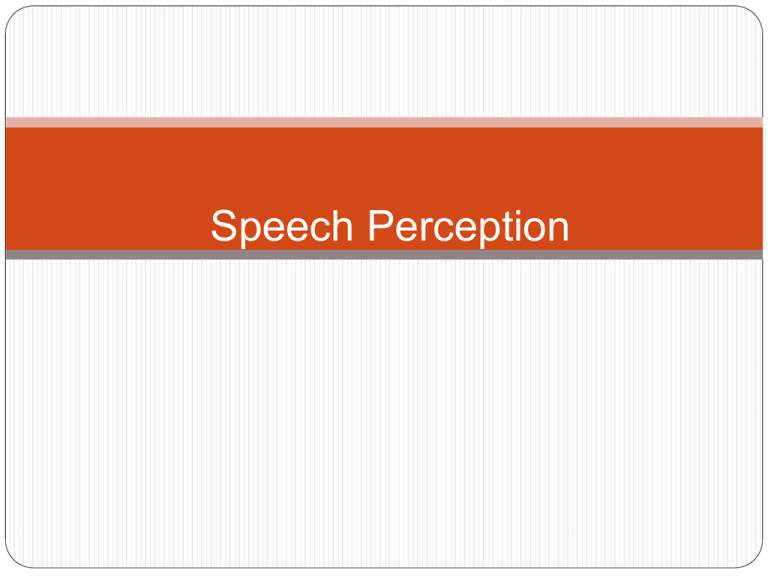
Speech Perception Overview of Questions Can computers perceive speech as well as humans? Does each word that we hear have a unique pattern associated with it? Are there specific areas in the brain that are responsible for perceiving and producing speech? “Language is something that goes in the ear and comes out of the mouth.” Norman Geschwind How do we make sounds? With the vocal tract. Figure 13.1 The vocal tract includes the nasal and oral cavities and the pharynx, as well as components that move, such as the tongue, lips, and vocal cords. The Acoustic Signal 1 Sounds are produced by air that is pushed up from the lungs through the vocal cords and into the vocal tract Vowels are produced by vibration of the vocal cords and changes in the shape of the vocal tract by moving the articulators (i.e, lips). These changes in shape cause changes in the resonant frequency and produce peaks in pressure at a number of frequencies called formants. Vowel sound formats i (eye) oo formats Left: The shape of the vocal tract for the vowels /I/ and /oo/. Right: the amplitude of the pressure changes produced for each vowel. The peaks in the pressure changes are the formants. Each vowel sound has a characteristic pattern of formants that is determined by the shape of the vocal tract for that vowel. The Acoustic Signal 2 The first formant has the lowest frequency, the second has the next highest, etc. Sound spectrograms show the changes in frequency and intensity for speech. Consonants are produced by a constriction of the vocal tract. (t) Formant transitions - rapid changes in frequency preceding or following consonants (tee) Basic Units of Speech Phoneme - smallest unit of speech that changes meaning of a word In English there are 47 phonemes: 13 major vowel sounds 24 major consonant sounds Number of phonemes in other languages varies— 11 in Hawaiian and 60 in some African dialects Tonal languages-pitch changes meaning Major consonants and vowels of English and their phonetic symbols Higher frequency format First format Figure 13.5 Hand-drawn spectrograms for /di/ and /du/. The Relationship between the Speech Stimulus and Speech Perception Variability from different speakers Speakers differ in pitch, accent, speed in speaking, and pronunciation. This acoustic signal must be transformed into familiar words. People perceive speech easily in spite of the variability problems due to perceptual constancy. Drive the car around the black Speech Perception is Multimodal 1 Auditory-visual speech perception The McGurk effect Visual stimulus shows a speaker saying “ga-ga.” Auditory stimulus has a speaker saying “ba-ba.” Observer watching and listening hears “da-da”, which is the midpoint between “ga” and “ba.” Observer with eyes closed will hear “ba.” VIDEO: The McGurk Effect http://www.youtube.com/watch?v=jtsfidRq2tw Figure 13.10 The McGurk effect. The woman’s lips are moving as if she is saying /ga-ga/, but the actual sound being presented is /ba-ba/. The listener, however, reports hearing the sound /da-da/. If the listener closes his eyes, so that he no longer sees the woman’s lips, he hears /ba-ba/. Thus, seeing the lips moving influences what the listener hears. Speech Perception is Multimodal 2 The link between vision and speech has a physiological basis. Von Kreigstein et al. showed that the FFA is activated when listeners hear familiar voices. This shows a link between perceiving faces and voices. Meaning and Phoneme Perception Experiment by Warren Listeners heard a sentence that had a phoneme covered by a cough. The task was to state where in the sentence the cough occurred. Listeners could not correctly identify the position and they also did not notice that a phoneme was missing -- called the phonemic restoration effect. Perceiving Breaks between Words The segmentation problem - there are no physical breaks in the continuous acoustic signal. Top-down processing, including knowledge a listener has about a language, affects perception of the incoming speech stimulus. Segmentation is affected by context, meaning, and our knowledge of word structure. Figure 13.11 Sound energy for the words “Speech Segmentation.” Notice that it is difficult to tell from this records where one word ends and the other begins. Figure 13.13 Speech perception is the result of top-down processing (based on knowledge and meaning) and bottom-up processing (based on the acoustic signal) working together. Speaker Characteristics Indexical characteristics - characteristics of the speaker’s voice such as age, gender, emotional state, level of seriousness, etc. Language and the Brain Broca’s and Wernicke’s areas were identified in early research as being specialized for language production and comprehension. Language is a whole brain task Motor and Sensory Strips Word meaning Broca’s Area KW 9-19 A1 Wernicke’s Area Speech comprehension KW 9-17 Experience Dependent Plasticity Before age one, human infants can tell difference between sounds that create all languages. The brain becomes “tuned” to respond best to speech sounds that are in the environment. Other sound differentiation disappears when there is no reinforcement from the environment. Speech Perception and the Brain Broca’s aphasia - individuals have damage in Broca’s area in frontal lobe Labored and stilted speech and short sentences but they understand others Wernicke’s aphasia - individuals have damage in Wernicke’s area in temporal lobe Speak fluently but the content is disorganized and not meaningful They also have difficulty understanding others and word deafness may occur in extreme cases. Music and the cortex Hearing and appreciating music is right hemisphere task. Comprehend music with right hemisphere. Production of music requires the left hemisphere as well. Trained musicians: music is language. Processing Music KW 9-24 The music’s over. End of slide show
